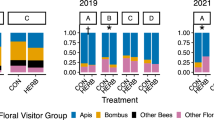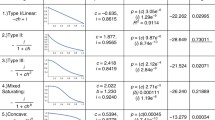Abstract
In this study, the non-additivity of effects of herbivores and pollinator on fitness of the plant Erysimum mediohispanicum (Cruciferae) has been experimentally tested. The abundance and diversity of the pollinator assemblage of plants excluded from and exposed to mammalian herbivores, and the combined effect of pollinators and herbivores on plant reproduction were determined over a period of 2 years. Pollinator abundance was higher and diversity was lower on plants excluded from herbivores. Furthermore, the experimental exclusions demonstrated that both pollinators and herbivores affected plant fitness, but their effects were not independent. Herbivores only had a detrimental effect on plant fitness when pollinators were present. Similarly, pollinators enhanced fitness only when herbivores were excluded. This outcome demonstrates that the importance of pollinators for plant fitness depends on the occurrence of herbivores, and suggests that herbivores may hamper pollinator-mediated adaptation in plants.


Similar content being viewed by others
References
Cook SM, Bartlet E, Murray DA, Williams IH (2002) The role of pollen odour in the attraction of pollen beetles to oilseed rape flowers. Entomol Exp Appl 104:43–50
Ehrlén J (1997) Risk of grazing and flower number in a perennial plant. Oikos 80:428–434
Ehrlén J (2002) Assessing the lifetime consequences of plant-animal interactions for the perennial herb Lathyrus vernus (Fabaceae). Perspect Plant Ecol Evol Syst 5:145–163
Ekbom B, Borg A (1996) Pollen beetle (Meligethes aeneus) oviposition and feeding preference on different host plant species. Entomol Exp Appl 78:291–299
Gómez JM (2002) Generalización en las interacciones entre plantas y animales. Rev Chil Hist Nat 75:105–116
Gómez JM (2003) Herbivory reduces the strength of pollinator-mediated selection in the Mediterranean herb Erysimum mediohispanicum: consequences for plant specialization. Am Nat 162:242–256
Gómez JM, Zamora R (2000) Spatial variation in the selective scenarios of Hormathophylla spinosa (Cruciferae). Am Nat 155:657–668
Gómez JM, Zamora R (2005) Ecological factors promoting the evolution of generalization in pollination systems. In: Waser N, Ollerton J (eds) Generalization and specialization in pollination systems. University of Chicago Press, Chicago (in press)
Hambäck PA (2001) Direct and indirect effects of herbivory: feeding by spittlebugs affects pollinator visitation rates and seedset of Rudbeckia hirta. Ecoscience 8:45–50
Herrera CM (1987) Components of pollinator “quality”: comparative analysis of a diverse insect assemblage. Oikos 50:79–90
Herrera CM (1989) Pollinator abundance, morphology, and flower visitation rate: analysis of the “quantity” component in a plant-pollinator system. Oecologia 80:241–248
Herrera CM (1996) Floral traits and plant adaptation to insect pollinators: a devil’s advocate approach. In: Lloyd DG, Barrett SCH (eds) Floral biology. Chapman and Hall, New York, pp 65–87
Herrera CM (2000) Measuring the effects of pollinators and herbivores: evidence for non-additivity in a perennial herb. Ecology 81:2170–2176
Herrera CM, Medrano M, Rey PJ, Sánchez-Lafuente AM, García MB, Guitián J, Manzaneda AJ (2002) Interaction of pollinators and herbivores on plant fitness suggests a pathway for correlated evolution of mutualism- and antagonism-related traits. Proc Natl Acad Sci USA 99:1683–1688
Karban R, Strauss SY (1993) Effects of herbivores on growth and reproduction of their perennial host, Erigeron glaucus. Ecology 74:39–46
Knight TM (2003) Floral density, pollen limitation, and reproductive success in Trillium grandiflorum. Oecologia 137:557–563
Krupnick GA, Weis AE, Campbell DR (1999) The consequences of floral herbivory for pollinator service to Isomeris arborea. Ecology 80:125–134
Lehtilä K, Strauss SY (1999) Effects of foliar herbivory on male and female reproductive traits of wild radish, Raphanus raphanistrum. Ecology 80:116–124
Leimu R, Syrjänen K (2002) Effects of population size, seed predation and plant size on male and female reproductive success in Vincetoxicum hirundinaria (Asclepiadaceae). Oikos 98:229–238
Mead R (1988) The design of experiments: statistical principles for practical applications. Cambridge University Press, Cambridge
Montgomery DC (1997) Design and analysis of experiments. Wiley, New York
Mothershead K, Marquis RJ (2000) Fitness impact of herbivory through indirect effects on plant-pollinator interactions in Oenothera macrocarpa. Ecology 81:30–40
Niesenbaum RA (1996) Linking herbivory and pollination: defoliation and selective fruit abortion in Lindera benzoin. Ecology 77:2324–2332
Potvin C (2001) ANOVA: experimental layout and analysis. In: Scheiner SM, Gurevitch J (eds) Design and analysis of ecological experiments. Oxford University Press, Oxford, pp 63–76
Poveda K, Steffan-Dewenter I, Scheu S, Tscharntke T (2003) Effects of below- and above-ground herbivores on plant growth, flower visitation and seed set. Oecologia 135:601–605
Quesada M, Bollman K, Stephenson AG (1995) Leaf damage decreases pollen production and hinders pollen performance in Cucurbita texana. Ecology 76:437–443
Quinn GP, Keough MJ (2002) Experimental design and data analysis for biologists. Cambridge University Press, Cambridge
Ruther J, Thiemann K (1997) Response of the pollen beetle Meligethes aeneus to volatiles emitted by intact plants and conspecifics. Entomol Exp Appl 84:183–188
SAS Institute (1997) SAS/STAT software: changes and enhancements through release 6.12. Cary, N.C.
Strauss SY (1997) Floral characters link herbivores, pollinators, and plant fitness. Ecology 78:1640–1645
Strauss SY, Conner JK, Rush SL (1996) Foliar herbivory affects floral characters and plant attractiveness to pollinators: implications for male and female plant fitness. Am Nat 147:1098–1107
Strauss SY, Siemens DH, Decher MB, Mitchell-Olds T (1999) Ecological costs of plant resistance to herbivores in the currency of pollination. Evolution 53:1105–1113
Underwood AJ (1997) Experiments in ecology: their logical design an interpretation using analysis of variance. Cambridge University Press, Cambridge
Waser NM (1983) The adaptive nature of floral traits: ideas and evidence. In: Real LA (ed) Pollination biology. Academic, New York, pp 241–285
Zamora R, Hódar JA, Gómez JM (1999) Plant-herbivore interaction: beyond a binary vision. In: Pugnaire F, Valladares F (ed) Handbook of functional plant ecology. Dekker, New York, pp 677–718
Acknowledgements
I sincerely thank Adela González Megías, Pablo Almaraz and Carolina Puerta Piñero for their help in the field and Mark Lineham for linguistic advice. Identifications were generously provided by Alberto Tinaut (Univ. de Granada; Lepidoptera), J. Carlos Otero (Univ. de Santiago de Compostela; Nitidulidae), Miguel Angel Alonso Zarazaga (CSIC; Curculionidae), Adela González Megías (Univ. de Granada; Malachidae) and Francisco Sánchez Piñero (Univ. de Granada; Meloidae). This work was partially supported by University of Granada Grant 2002-30P-3176 and Ministerio de Ciencia y Tecnología Grant BOS2003-01095.
Author information
Authors and Affiliations
Corresponding author
Rights and permissions
About this article
Cite this article
Gómez, J.M. Non-additive effects of herbivores and pollinators on Erysimum mediohispanicum (Cruciferae) fitness. Oecologia 143, 412–418 (2005). https://doi.org/10.1007/s00442-004-1809-7
Received:
Accepted:
Published:
Issue Date:
DOI: https://doi.org/10.1007/s00442-004-1809-7




